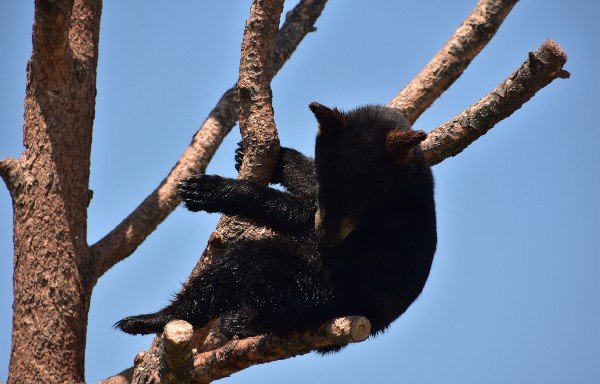Black bears, scientifically known as Ursus americanus, are predatory omnivores with digestive systems that align more closely with other omnivores than pure carnivores. Thanks to their elongated digestive tracts, they are more efficient at processing vegetation than many other carnivorous species. However, unlike ruminants (such as deer or cows), bears lack a cecum, an essential organ for digesting fibrous plant materials like cellulose. This means they cannot fully break down and digest plant structures. To make up for this, black bears are highly selective in the plant materials they consume, prioritizing plants during their most nutrient-dense and digestible stages of growth.
Black Bears’ Dietary Needs
So, what exactly do black bears eat? The diet of a black bear is highly varied and opportunistic. While they are classified as omnivores, plants make up the majority of their diet, complemented by animal-based protein when it is available. They favor grasses, berries, roots, and other vegetation, but they also enjoy:
- Insects and larvae
- Fish
- Water-rich plants
- Honey
- Carrion (dead animals)
- Meat from young deer, moose, and elk, as well as domestic livestock like sheep
Black bears are quick learners and can easily adapt to human environments if food is readily available. This includes raiding cattle and pet feed, as well as human garbage. Unfortunately, when bears begin associating human habitats with food, they may be deemed a threat or a nuisance, often resulting in human intervention or lethal control measures.
Seasonal Feeding Patterns
Black bears are highly adaptable and will take advantage of any food source available throughout the year. Their diet changes with the seasons to maximize the availability of nutrients. Here’s a closer look at what black bears eat during different times of the year:
Spring: A Time of Regeneration
In the spring, after hibernation, black bears primarily forage for fresh, tender plants. At this time of year, leaves and flowers contain the highest levels of protein, and their cell walls haven’t fully developed the tough cellulose and lignin, making them easier to digest. Bears will graze on clovers, dandelions, catkins, and various grasses. In addition to foraging, they may also prey on young, vulnerable animals like fawns or the calves of moose and deer.
Summer: Berries and Insects
During the summer months, black bears shift their focus to softer fruits and berries that come into season. Strawberries, blueberries, raspberries, and dogwoods are some of their favorite summer treats. Protein intake comes primarily from insects like beetles, wasps, and ants, which the bears can easily forage. This season provides abundant food sources, allowing bears to restore the energy they lost during hibernation.
Fall: Packing on the Pounds
Fall is the most critical feeding season for black bears as they prepare for hibernation. Their primary goal is to consume as much food as possible to store fat for the long winter months. Black bears living near coastal regions rely heavily on fish as a rich protein source during this period. Elsewhere, they consume root vegetables, grass, carrion, and any injured prey they can find. Fall is when bears’ metabolism shifts into overdrive, and their foraging activity intensifies as they prepare for hibernation.
Winter: Hibernation Mode
Like grizzly bears, black bears typically enter hibernation around November or December, depending on the region. During this time, they will not eat, relying instead on the fat reserves they’ve built up throughout the fall to survive the cold months. Black bears hibernate to avoid the harsh winter conditions and scarcity of food, and this period of dormancy allows them to conserve energy. In contrast, black bears in warmer climates do not hibernate at all. These bears may continue foraging for human food, trash, or winter-killed animals throughout the colder months.
Black Bears vs. Grizzly Bears: Dietary Comparisons
In Yellowstone and other overlapping habitats, black bears and grizzly bears often eat the same types of food, but there are notable differences in how they acquire their meals. Black bears, with their shorter and more curved claws, are skilled climbers, making them better suited for foraging for berries, nuts, and fruits high in trees. They tend to eat less meat and fewer roots than grizzly bears, focusing more on plant-based foods.
Grizzlies, on the other hand, have longer, straighter claws that allow them to dig more efficiently. They use these powerful claws to unearth roots, bulbs, tubers, and even small mammals. Additionally, grizzly bears have a more massive shoulder muscle mass, which helps them dig into the ground to access rodents and their caches. As a result, grizzlies consume more meat and underground plant matter compared to black bears, who primarily feed on plants found above ground.
Black Bears are Versatile Feeders
Black bears are incredibly versatile feeders, adapting their diets to the seasons and the availability of food sources. While primarily plant eaters, they also rely on animal proteins when needed, particularly as they prepare for hibernation. Their digestive systems are uniquely adapted to handle large amounts of vegetation, but they still seek out high-quality, nutrient-dense foods. Understanding the dietary habits of black bears not only highlights their adaptability but also underscores the importance of conserving their natural habitats to ensure they have access to the food they need.
With this knowledge, we can better appreciate these majestic creatures and contribute to their protection in the wild.






